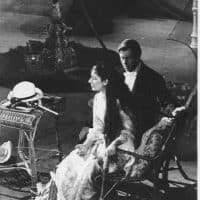When I talk to people who don’t know anything about opera, the thing that seems to shock them the most is the fact that no one uses microphones: not the singers, not the orchestra, and often not even the dreaded announcer who has stepped onstage to tell the audience that the tenor has a cold.
I suppose in this modern age, where almost every other type of music is amplified in some way, it’s shocking that opera is completely unamplified. This shock could also be compounded by the average American’s conception of an opera house, which is generally the size of the Metropolitan Opera. It seems inconceivable that the human voice alone could reach to the last seat in such a big place.
What people don’t know is that opera singing is unique and the technique focuses on projecting the voice not only to the last seat, but over a full orchestra. The orchestration varies for each opera (light and small for Baroque and Classical, dense and large for Romantic and beyond) and this is why Wagnerian singing, for example, is so impressive. Wagnerian singers must compete with a huge, loud orchestra and they usually sing for long periods of time in larger sized houses. These stipulations call for a strong technical and physical ability and makes this voice type more rare than other types of operatic voice types.
The projection needed for opera singing is created in two ways: strength of airflow (supported by the body and diaphragm) and focus of vocal resonance. A singer must train to build the muscles necessary to project his or her voice. They must also learn how to resonate most efficiently so they can create a focused tone that will travel and cut through the orchestra. This technique and strength takes time to master. That’s why operatic “young artists” can be 35 years old.
Opera singers are in a unique position because they represent an art form that existed before microphones. They carry the traditions of another era. Of course, the technique is always improving and houses are being constructed for better acoustics, but the idea has been the same since the first operas of the 17th century.
The thing I love most about unamplified acoustics is that there is a direct connection between the performer and the audience. There is literally nothing between them. In a live performance, the audience experiences the performer’s voice exactly as it is. There’s nothing to auto-tune or add reverb. There is no change or degradation in the singer’s natural tone and ability. For once, the audience is hearing the music as it truly is.
For me, this is the greatest draw for live opera and this is why I’ll go again and again to the opera house. I’ll drive hours and give up natural comforts just to see a live performance. There’s something alive and different and intimate about it. Even in a 4,000 seat house like the Met, you can feel close to a performer through the sheer, unadulterated sound of their voice. Add to that the in-the-moment collaboration of hundreds of musicians and you have something completely unique.
I’ll never forget one of the first operas I ever saw. I was sitting in the very last row at the Met and mezzo Susan Graham was singing Sesto in Mozart’s La Clemenza di Tito. When she sang “Deh, per questo,” I felt all the impact of the heartbreak and desperation of her character as though she was standing right in front of me. I didn’t lose any of the nuances or beauty of that moment. I was in the last row, hundreds of feet away from her, but it felt as though she was singing just for me. From that point on, I’ve been hooked.
If you haven’t experienced a live opera, do yourself a favor and just do it.









